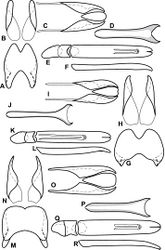Baconia obsoleta
| Notice: | This page is derived from the original publication listed below, whose author(s) should always be credited. Further contributors may edit and improve the content of this page and, consequently, need to be credited as well (see page history). Any assessment of factual correctness requires a careful review of the original article as well as of subsequent contributions.
If you are uncertain whether your planned contribution is correct or not, we suggest that you use the associated discussion page instead of editing the page directly. This page should be cited as follows (rationale):
Citation formats to copy and paste
BibTeX: @article{Caterino2013ZooKeys343, RIS/ Endnote: TY - JOUR Wikipedia/ Citizendium: <ref name="Caterino2013ZooKeys343">{{Citation See also the citation download page at the journal. |
Ordo: Coleoptera
Familia: Histeridae
Genus: Baconia
Name
Baconia obsoleta Caterino & Tishechkin, 2013 sp. n. – Wikispecies link – ZooBank link – Pensoft Profile
Type locality
BRAZIL: Santa Catarina: Nova Teutonia [27.18°S, 52.38°W].
Type material
Holotype male: “BRÉSIL X-77 Santa Catarina Nova Teutonia F. Plaumann” / “Caterino/Tishechkin Exosternini Voucher EXO-00651” (FMNH). Paratype (1): same data as type but collected xii.1969 (FMNH).
Diagnostic description
Length: 2.2–2.3mm, width: 2.0–2.1mm; body ovoid, convex, glabrous; piceous, shining; frons weakly elevated over antennal bases, depressed in middle, interocular margins convergent dorsad, frontal disk with few coarse punctures in median depression and few across vertex, frontal stria present along inner edges of eyes, just bent mediad at sides, otherwise absent across middle; supraorbital stria absent; antennal scape short, club broadly rounded, subtruncate apically; epistoma convex across apex, apical margin straight; labrum with distal edge weakly carinate, emarginate; mandibles rather short, stout, each with basal tooth; pronotal sides convergent from base, more strongly arcuate to apices, lateral marginal striae continuous around sides and front, submarginal stria absent; pronotal disk with anterior corners depressed, with series of large, coarse punctures along posterior margin, smaller punctures present in lateral thirds, only fine ground punctures present at middle; elytra with two complete epipleural striae and fragments of an additional one further laterad, outer subhumeral stria absent, inner subhumeral stria present as short basal fragment, dorsal striae 1-2 more or less complete, 3rd stria present in basal half, 4th and 5th striae absent, sutural stria present for short distance at middle, obsolete in basal and apical thirds, elytral disk with small, sparse punctures in apical third; prosternal keel weakly convex, emarginate at base, carinal striae subparallel basally, diverging anterad, complete, free; prosternal lobe short, about one-half keel length, apical margin rounded, marginal stria well impressed at middle, obsolete at sides; mesoventrite produced at middle, marginal stria complete; mesometaventral stria sightly arched forward at middle, crenulate, slightly detached from inner lateral metaventral stria (at least in types), which curves obliquely posterolaterad toward middle of hind coxa, outer lateral metaventral stria subparallel, about half as long as inner; metaventral disk impunctate at middle; abdominal ventrite 1 with inner lateral stria present in basal half only, outer lateral stria absent, disk with few punctures across middle of posterior margin; protibiae 4-dentate, outer margin finely serrulate between spines; mesotibia with one marginal spine; outer metatibial margin smooth; propygidium lacking basal stria, with coarse secondary punctures separated by slightly more than their diameters in basal half, smaller and much sparser posterad, propygidial glands inconspicuous; pygidium with fine ground punctation very sparsely interspersed with small secondary punctures, predominantly along basal margin. Male genitalia (Figs 29M–R): T8 shorter than broad, widest at middle, sides outwardly arcuate, basal emargination appearing weakly triangulate, basal rim well-sclerotized, apex shallowly, acutely emarginate, ventrolateral apodemes projecting very weakly beneath, extending nearly halfway along length, but inner apices widely separated; S8 divided, slightly longer than T8, inner margins rather well separated in basal fourth, divergent apically, outer margins weakly rounded, convergent, apical guides most strongly developed at their bases, narrowed strongly to apices, apical velar membrane absent, apex lacking conspicuous setae; T9 with basal apodemes rather thin, about one-third total length, T9 apices narrowly rounded, glabrous, ventrolateral apodemes weakly projecting beneath; S9 rather broad, sides subparallel in basal half, base rounded, apex gradually expanded, apical emargination broadly, shallowly emarginate, broadly desclerotized along midline, moreso in apical half; tegmen with sides subparallel, weakly narrowed in apical third, tegmen more or less straight in lateral aspect, weakly curved ventrad in apical fifth; median lobe broad, almost one-half tegmen length; basal piece short, about one-fourth tegmen length.
Remarks
This species is strongly convex, with the pronotal disk narrowed rapidly from base, and pronotal punctures relatively widespread (Fig. 28E). Like Baconia crassa and Baconia turgifrons, this species completely lacks the 4th and 5th elytral striae, but Baconia obsoleta does not have the peculiar epistomal modifications of either of these species.
Etymology
This species’ name refers to the extensively effaced elytral striae.
Original Description
- Caterino, M; Tishechkin, A; 2013: A systematic revision of Baconia Lewis (Coleoptera, Histeridae, Exosternini) ZooKeys, 343: 1-297. doi
Images
|


